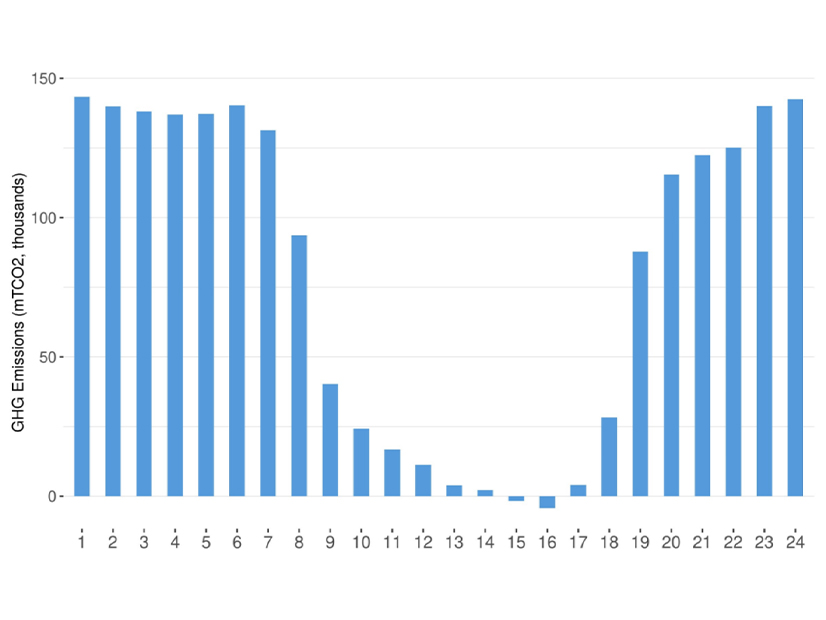CAISO is recommending it implement a Western Power Trading Forum (WPTF) proposal that could help the Extended Day-Ahead Market track and account for greenhouse gas emissions in a way that considers the variety of carbon pricing programs across the West.
Central to the proposal, first presented by WPTF in March, is use of residual market supply — energy not committed to market participants or attributed to GHG regulation areas.
The proposal assumes that if the market can ensure entities are able to claim and procure their own resources to meet load, what is left is a relatively small increment of energy, which is the residual supply, Clare Breidenich, WPTF assistant executive director, explained at a March meeting of the ISO’s Greenhouse Gas Coordination Working Group.
The residual supply helps determine a residual emissions rate, which represents a dispatch-weighted average emission rate of the market supply. Under this framework, leftover energy in the market would go into the residual supply. (See CAISO, Stakeholders Consider 2 GHG Mechanisms for EDAM.)
“This conversation around a residual rate is going to be robust in terms of how we calculate that,” Anja Gilbert, a lead policy developer at CAISO, said in a Sept. 19 meeting of the GHG group. “There’s questions on how we think about a residual rate for price-based states, for states with climate policies not based on a price, and then for states that do not have climate policies.”
Portland General Electric Weighs in
Pam Sporborg, director of transmission and market services at Portland General Electric (PGE), weighed in on how states like Oregon that don’t price carbon but do have climate policies could incorporate the proposal.
While Oregon doesn’t put a price on GHGs, the state requires utilities such as PGE to reduce emissions every year until the utility is “under the 2030 hard cap for emissions that is based on an 80% reduction from a reference level.”
“While that doesn’t necessarily entail a price on those emissions, we do see it as a hard limit, which can indicate that we have a significant willingness to pay for those emissions,” Sporborg said. “While we really like the structure and framework in this proposal, we want to open up some questions around how we can also ensure that capped states are having an equitable allocation or equitable access to the excess emissions framework consistent with or alongside of the GHG pricing zone states.”
Connie Horng, PGE’s principal greenhouse gas policy analyst, presented an alteration to the proposal, suggesting that if an LSE inside the GHG pricing area has excess designated energy, those megawatt hours and associated GHGs would be assigned to another LSE inside the pricing zone before being allocated to the residual market supply. Within this framework, PGE proposed looking beyond just a GHG pricing zone adjustment and incorporating a methodology that would be able to reflect all GHG regulated zones — including non-priced ones.
“How do we expand from just the pricing zones that impact Washington and California to include the regulation that applies to Oregon and potentially other states who have these strong caps and a compliance framework associated with GHG?” Horng said. “Our goal here is to allow all of the GHG-regulated states with the clean energy portfolio requirements that we are bringing to the market to solve for each other’s excesses and shortfalls first, before we get that residual market calculation.”
Gilbert questioned how the ISO might modify the approach to account for PGE’s suggestion.
“Are we looking to modify the WPTF approach for price-based regions to include states like Oregon? Or is a separate residual rate for Oregon that is applied to Oregon LSEs or BAAs required?”
Sporborg said PGE was open to both solutions, but thinks they need to be explored more thoroughly.
“Our goal is to really maximize the diversity benefits from the states,” Sporborg said. “Even though we don’t have the pricing component to our regulation, we will still be making investments in a diverse portfolio of clean energy supply to meet our 2030 goal. … If we can find an opportunity that allows us to participate in the broadest regional diversity and to also benefit from the greening of the portfolios that will create this residual excess, I think that is the solution that we would want to get to optimally.”
The ISO is seeing feedback on PGEs proposal in written comments and will continue to discuss it in later working groups.


